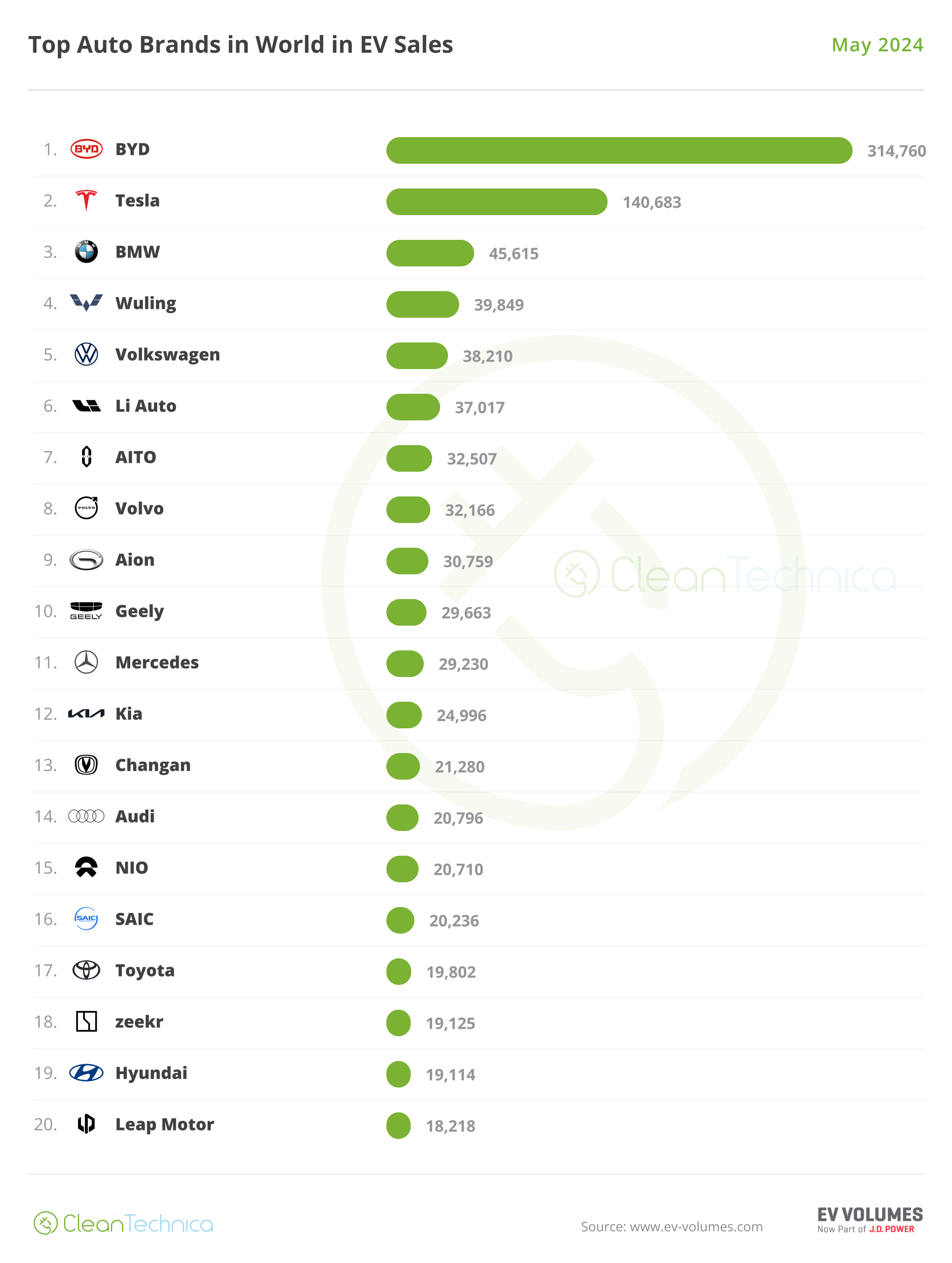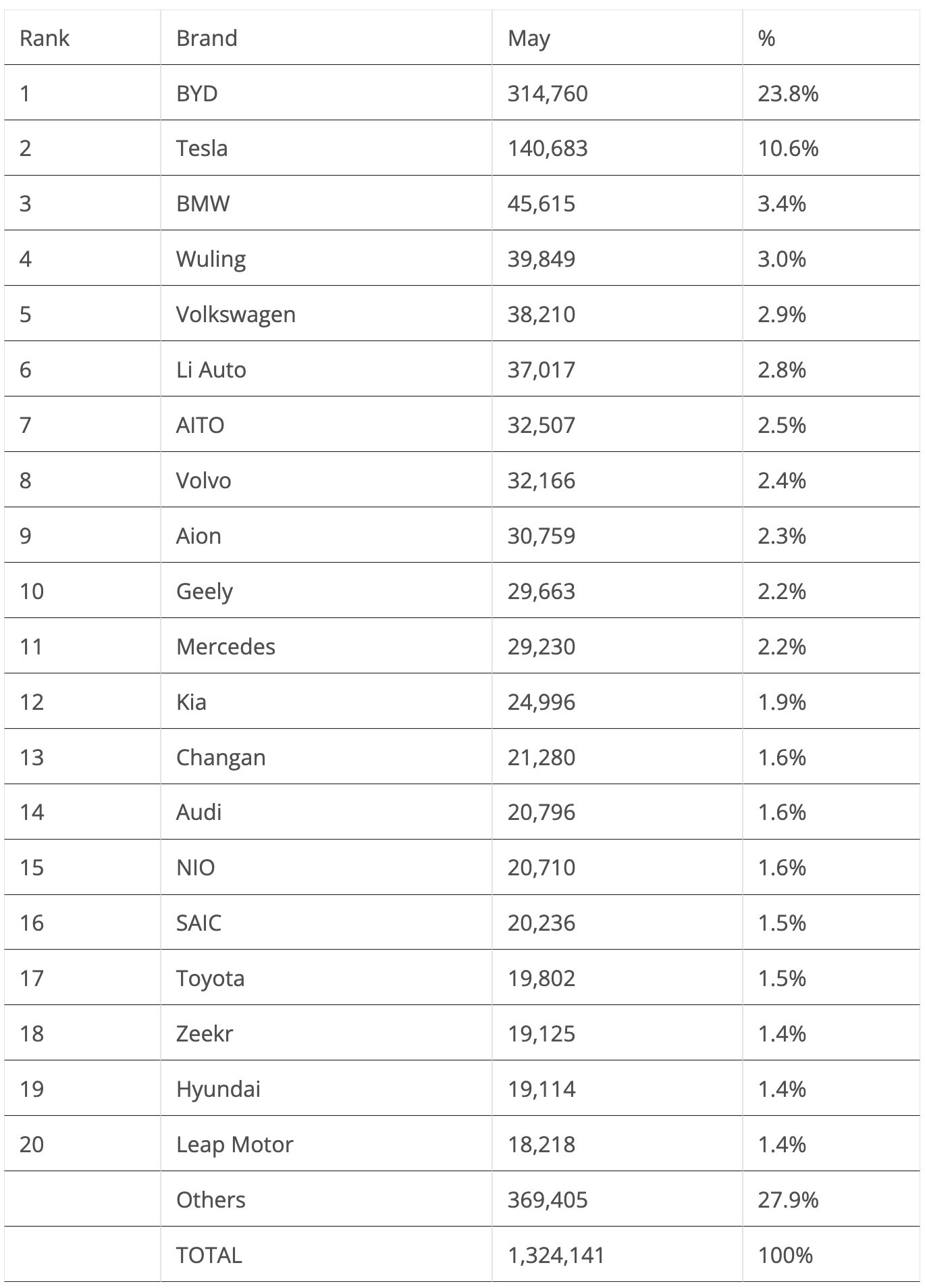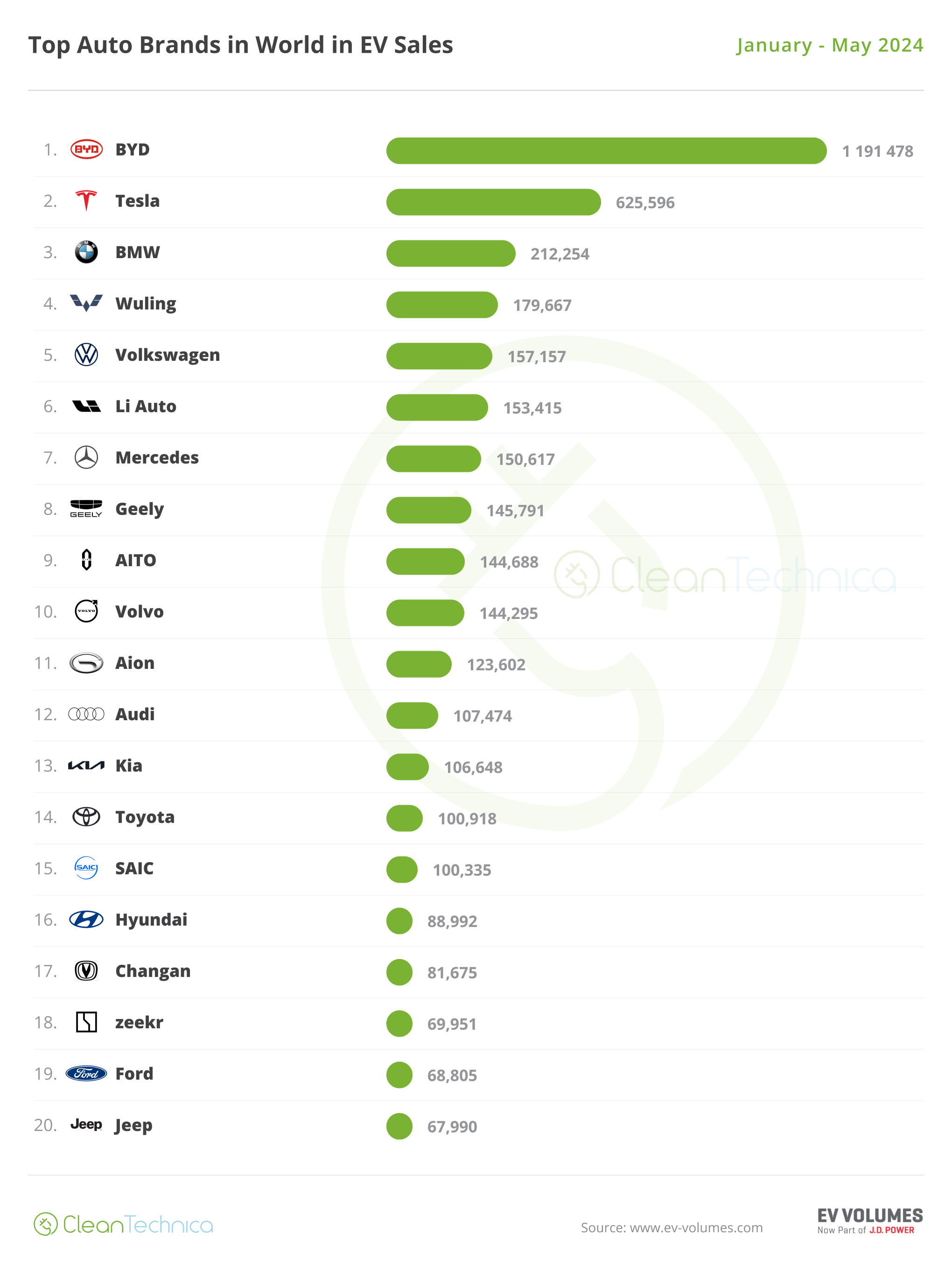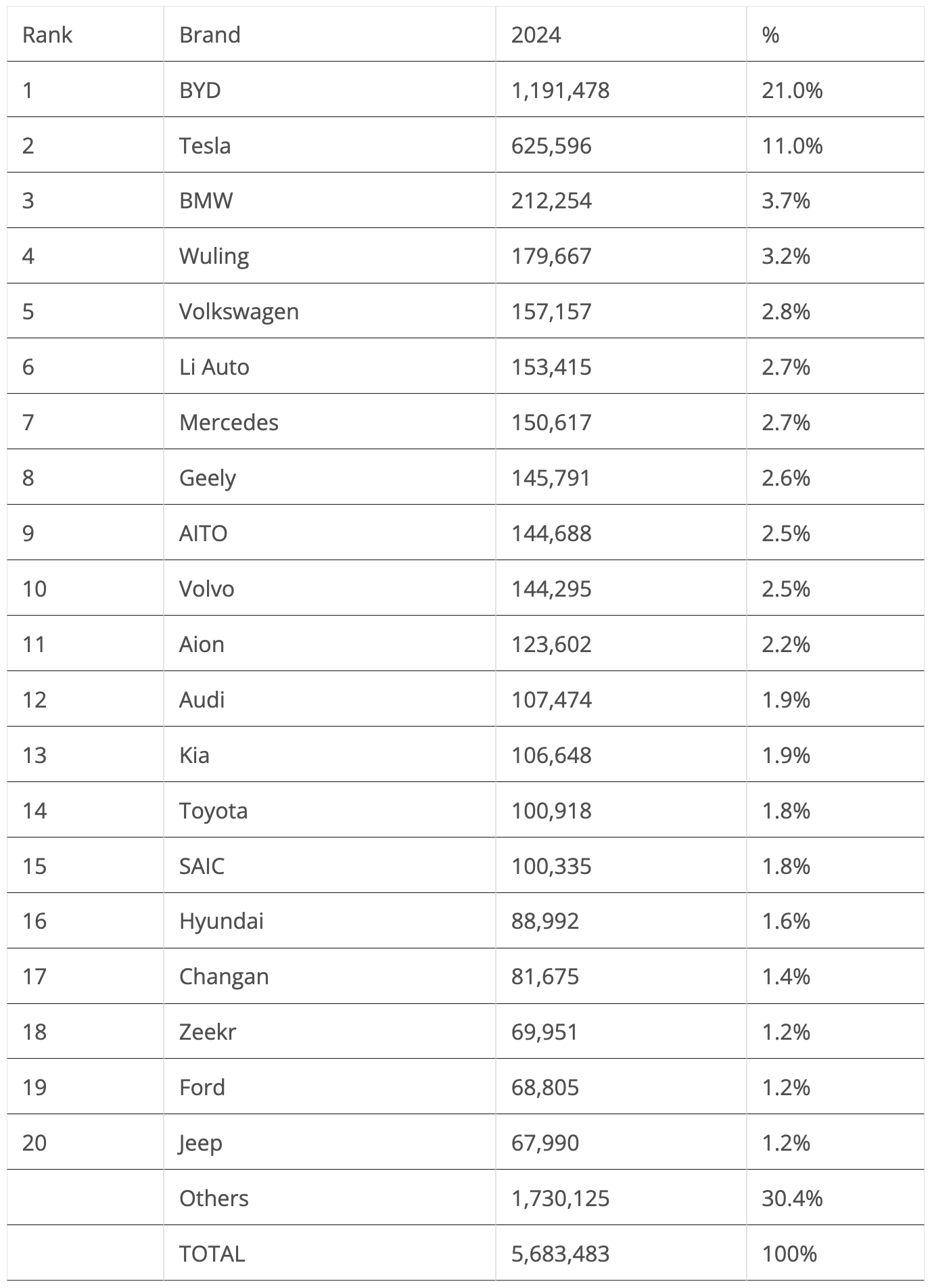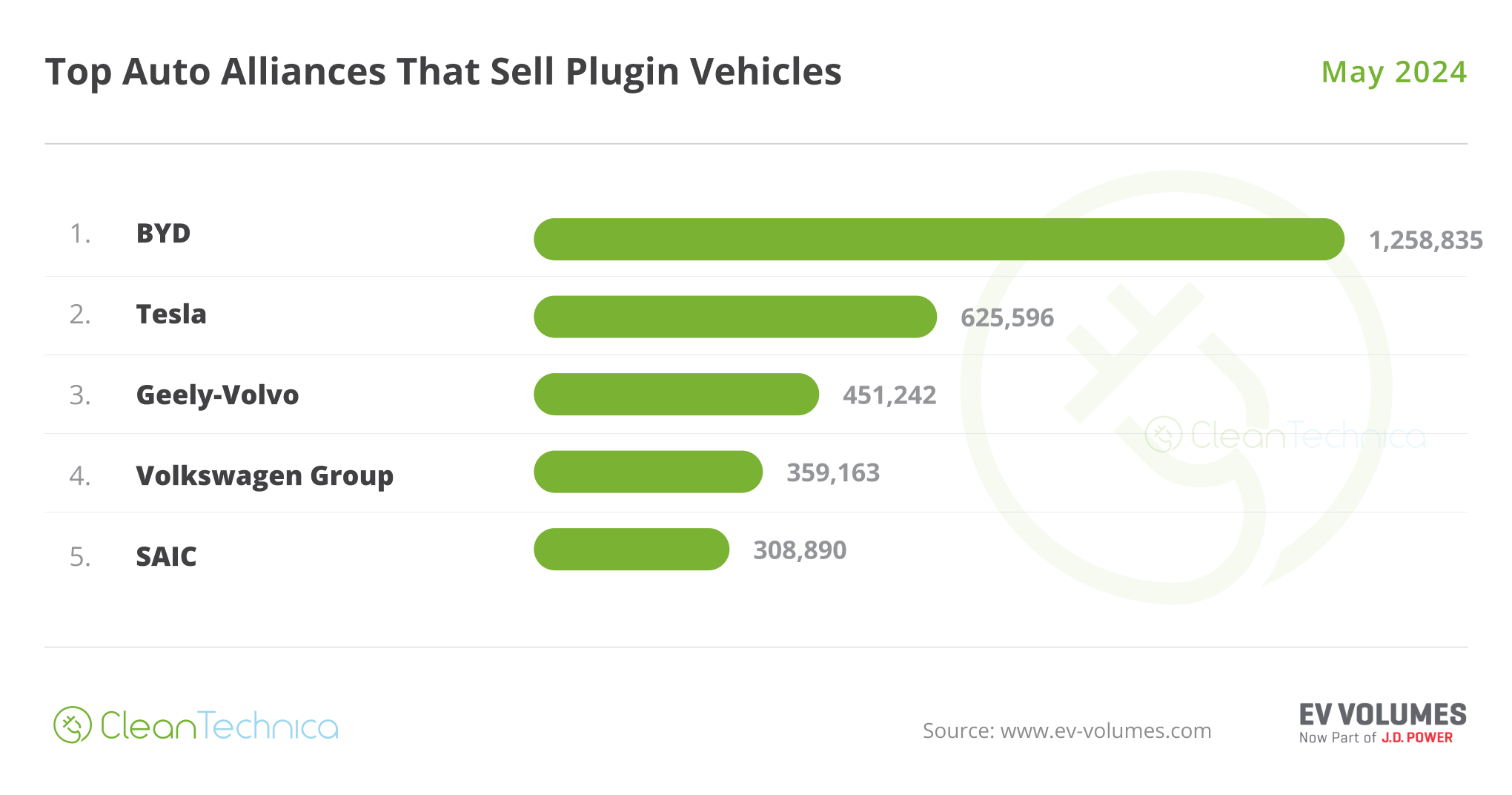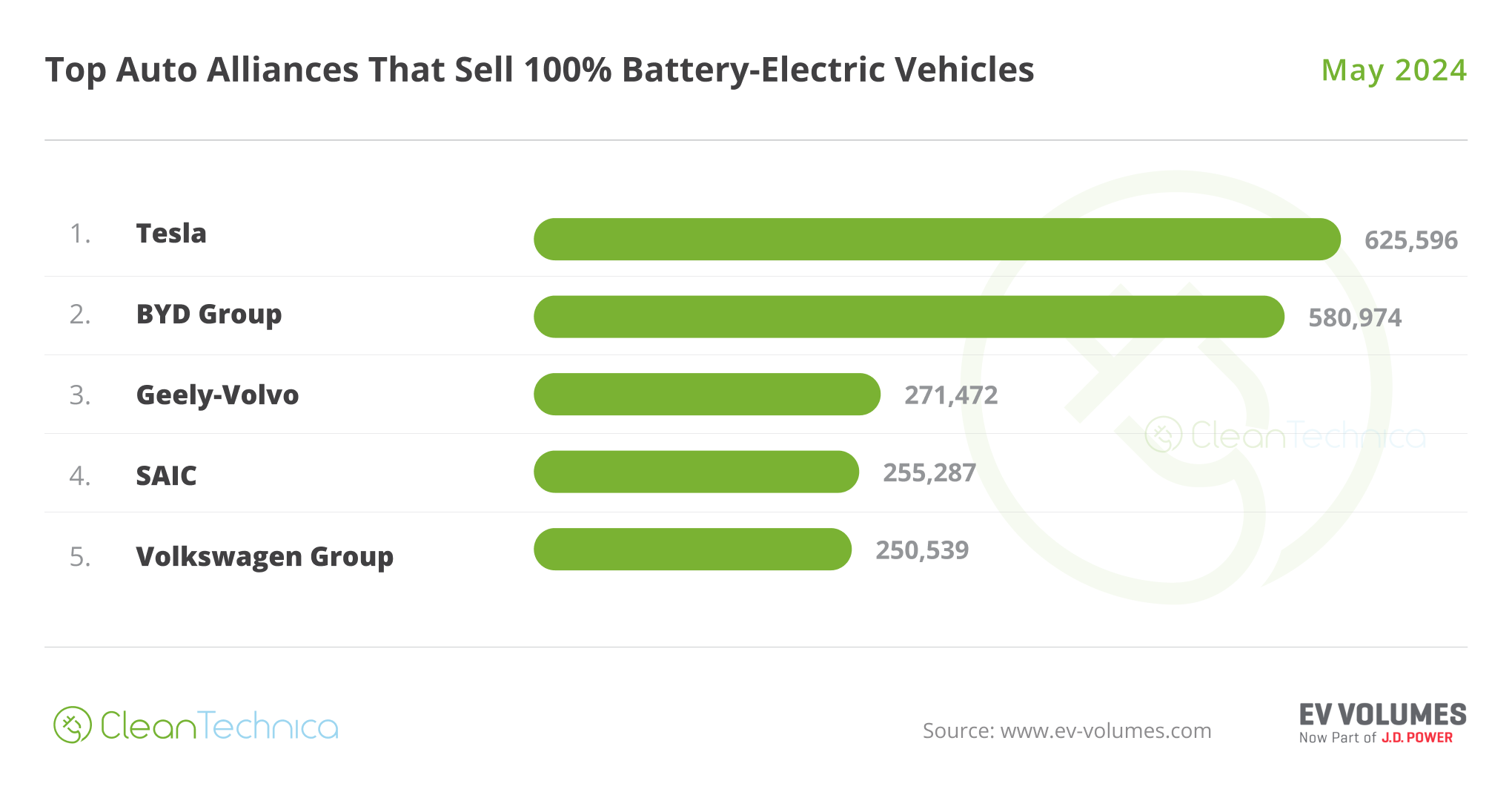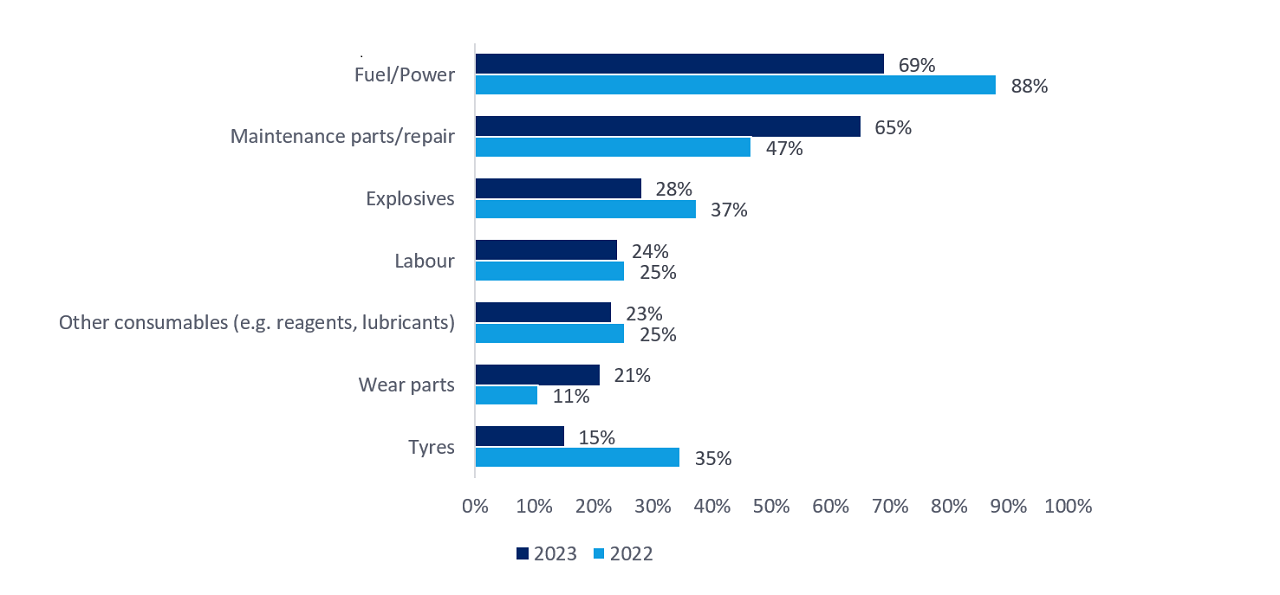Sign up for daily news updates from CleanTechnica on email. Or follow us on Google News!
We’ve already written about the top selling electric car models in the world in the month of May. Now let’s look at the brands and OEMs selling the most electric vehicles.
Top Selling Brands
In May, #1 BYD, now deep into pricing out the ICE competition (and quite a few other EVs on the way…), didn’t disappoint. It scored some 314,000 registrations, its second best result ever, only behind last December’s score. Expect its sales to continue steadily rising throughout the year.
Looking closer at the BYD sales breakdown, while the BEV side of sales continues to grow at a steady pace (+22% in May), it is the PHEV side that is really shining, jumping 54% YoY. May was its 3rd record month in a row, with some 172,000 units delivered. BYD’s PHEVs continue to profit from pricing out the ICE competition. Imagine that — a PHEV being cheaper than its equivalent petrol model … now this is disruption!
As for Tesla, after the recent sales drops, May’s result brought encouraging numbers. The company’s 140,000 registrations represent a 300-unit increase compared to the same month last year. This is in part thanks to the volume increase of the Cybertruck, now at over 2,000/month. May saw an effectively flat growth rate, but that is welcome news after three straight months of falling sales. Still, YTD, sales are still down by 8% YoY, so June will be important to getting better insight into Tesla’s sales behavior this year. If June sees a return to growth, then it will seem that the worst is over. If not, then May was a blip and 2024 could well be the first year of dropping sales for the US make.
Below the top two galactics, BMW again won the last position on the podium. Volkswagen, now looking to recover on lost time, ended in 5th with 38,210 registrations, a new year best — much thanks to good results from its star players, the ID.4 and ID.3.
Another brand looking to be back on track is Li Auto, with the startup benefitting from the L6 launch to score a new year best performance of 37,017 sales.
The second half of the table saw a surprising NIO perform a record result, getting 20,710 registrations, much thanks to the good results of the ES6 SUV and the ET5 sedan/station wagon (I wish all the luck for NIO’s ET5 wagon — we need more load luggers like these to help people get off crossovers and SUVs).
Kia ended May in 12th, with 24,996 units, its best result in 10 months, and with the upcoming EV5 and EV3 landing soon, expect the Korean make to continue expanding sales throughout the year.
A final mention goes out to Leap Motor, which joined the best sellers table in #20 with 18,218 registrations, a new year best. Is this another Chinese brand to follow closely?
In April, known brands like Ford, Peugeot, and Jeep were left out of the top 20, being replaced by more Chinese brands. Overall, China had 11 brands in the top 20.
In the YTD table, there wasn’t much to report at the top. BYD is ahead of Tesla, and the US brand has almost three times as many registrations as #3 BMW. But while BYD continues to grow by double digits, Tesla’s sales are down 8% in 2024….
Far below these two, which are really in a league of their own, BMW and Wuling stayed in their positions, while Volkswagen benefitted from a strong month of May to jump another position, this time to 5th. Now, will the German make be able to recover ground on the #4 Wuling and threaten the Chinese brand? Please place your bets.
Li Auto and its rival AITO both gained one position in May, with the former climbing to #6 and the latter to #9. A major factor helping Li Auto to beat AITO on the global stage is that while AITO is basically selling only in China, Li Auto has set up a successful business in Russia, with the startup brand selling an average of over 2,000 units per month in the Eurasian country, satisfying that market’s thirst for big SUVs. The fact that they are plugin hybrids is just a secondary effect….
With Li Auto landing soon in the Middle East, expect the startup brand to be another Chinese EV automaker leaving China’s Jurassic EV Park and spreading panic among the established competition.
In the second half of the table, Kia benefitted from a good month in May, and jumped two positions, to 13th, thus compensating for a poor month from stablemate Hyundai.
The remaining highlight came from Zeekr, which joined the table in 18th. As it is, Geely is the only OEM with more than two brands in the table — the namesake brand is 8th, Volvo is 10th, and now Zeekr is 18th.
Ford and Jeep were relegated to #19 and #20, respectively, and with #21 Leap Motor (66,674 units) and #22 NIO (66,236), looking dangerously close, we could see both US brands being kicked out of the table in exchange for the two Chinese startups, which would elevate the number of Chinese brands in the top 20 to 11 representatives.
Top Selling OEMs for EV Sales
Looking at registrations by OEM, #1 BYD gained share thanks to its recent price cuts, going from 20.8% to its current 22.1% (it had 21.9% a year ago), while Tesla ended May with 11% share (it had 14.8% in the same period of 2023).
3rd place is in the hands of Geely–Volvo, with the OEM climbing from 7.8% in April to 7.9% in May. The Chinese OEM is the one that most progressed in the top 5, going from 6.2% in May 2023 to its current 7.9%.
Considering Tesla’s recent share drop and Geely’s significant growth, will we see the Chinese juggernaut threaten Tesla’s silver medal by year end?
Meanwhile, #4 Volkswagen Group (6.3%) remained stable, gaining some distance over #5 SAIC (5.4%, down from 5.6%). Although, comparing results with the same period of 2023, the German OEM is faring much worse, as it is down by 1% share, while SAIC has remained relatively stable (5.4% now vs. 5.6% then).
Below SAIC, a free-falling Stellantis (3.9%, down from 4%) dropped two positions in one month, to 8th. It was surpassed by both BMW Group and Changan, and has lost significant share compared to May 2023, when it had 4.8%.
The multinational conglomerate needs to react fast — its cheap EVs (Citroen e-C3 EV, e-C3 Airscross EV, Opel Frontera EV, Fiat Grande Panda EV, etc.) need to land as soon as possible, and in significant volumes (a refresh on the Fiat 500e wouldn’t hurt either…). This year, Stellantis not only lost touch with the top 5 OEMs, but it is at risk of being swallowed by the competition.
With BMW, Changan, and Stellantis separated by fewer than 600 units, a lot can happen in the race for 6th, but for now, BMW Group (3.9%) is following the pack, with #9 Hyundai–Kia (3.5%) not too far behind, either.
 Chip in a few dollars a month to help support independent cleantech coverage that helps to accelerate the cleantech revolution!
Chip in a few dollars a month to help support independent cleantech coverage that helps to accelerate the cleantech revolution!
Looking just at BEVs, Tesla remained in the lead with 17.2%, but it has lost 4% share compared to the same period last year. With this, the US make is still ahead of BYD (16%, down 0.2%). With Tesla losing share at a rapid pace, though, we might see BYD surpass it around Q4.
Geely–Volvo (7.5%, up 0.3%) continues to rise, thanks to good results across its long lineup of brands. It gained more of an advantage over #4 SAIC (7%, down from 7.1%), allowing it to keep the bronze medal.
In 5th we have Volkswagen Group with 6.9%, up 0.1%. The German OEM is looking to reach the two companies ahead of it, and SAIC is not that far now. With #6 BMW Group (4.3%, up from 4.1% in April) at a safe distance, the German conglomerate could try to recover lost time in the coming months.
Have a tip for CleanTechnica? Want to advertise? Want to suggest a guest for our CleanTech Talk podcast? Contact us here.
Latest CleanTechnica.TV Videos
CleanTechnica uses affiliate links. See our policy here.
CleanTechnica’s Comment Policy

